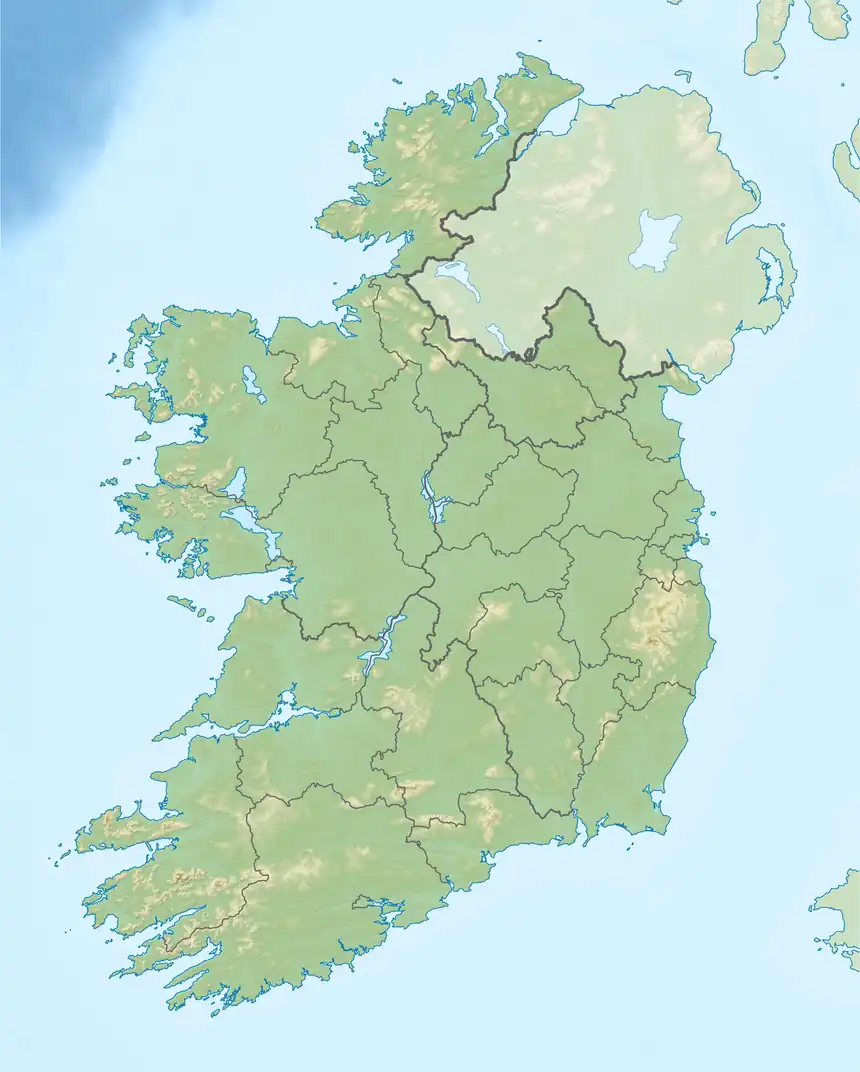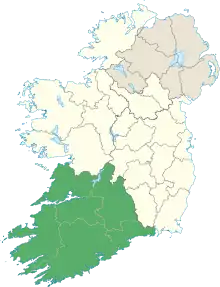Drung Hill
Drung Hill (Irish: Cnoc Droinge)[1] is a hill on the Iveragh Peninsula of southwestern Ireland. Overlooking the Atlantic Ocean, its summit is 640 metres (2,100 ft) tall. Like the peak of Knocknadobar to the west, it has been a Christian pilgrimage site since pre-Christian times.[2]
| Drung Hill | |
|---|---|
| Cnoc Droinge | |
.jpg.webp) Drung Hill with inspection car likely about 1893 | |
| Highest point | |
| Elevation | 640 m (2,100 ft)[1] |
| Coordinates | 52°1′36″N 10°2′11″W |
| Geography | |
 Drung Hill | |
| Parent range | Mountains of the Iveragh Peninsula |
| OSI/OSNI grid | V603878[1] |
History
The name of the hill means 'gathering place' in Gaelic.[2]
Historically, the summit served as a boundary marker between different kingdoms.[2]
Until 1880, the harvest festival of Lughnasa was held at the end of every July on the summit. On the last Sunday of July, Domhnach na dTuras ('Pilgrimage Sunday') would be held, during which there would be gatherings on the summits of Drung Hill and Knocknadobar, with special meals cooked in open fires.[2] In the November 1913 issue of the Kerry Archaeological Magazine, M. J. Delap reported that pilgrims came from as far as Limerick.[3]
Sites of interest
There are two cairns on an old road below the summit of Drung Hill. The larger cairn, which has a diameter of approximately 30 metres, is known as Laghtfinnan and may have been erected in prehistoric times.[2] Laghtfinnan was likely a Bronze Age or Neolithic burial site. On top of the cairn, there is a leacht with an Ogham inscription on it that reads [...] MAQI R[...], signifying that the name of the commemorated person's father began with the letter R.[4]
Cahircanaway (also written as Cahir-Canaway),[5] the smaller of the two cairns, is 2.5 metres high. It may have been the site of the inauguration of Fineen MacCarthy Reagh,[6] the final Mac Cárthaigh Mór, by the Ó Súilleabháin Mór (O'Sullivan Mor) in January 1600.[2]
Tobar Fhíonáin (Gaelic: 'Fionán's well'), a former holy well on Drung Hill named after St Fionán of Iveragh (Iveragh's most important saint), was also likely used during pilgrimage rituals.[2]
Access
A section of the Kerry Way known as the Butter Road crosses through the northern slopes of Drung Hill.[7] The path was used to transport butter and other goods from Cork to Kerry.[6]
See also
References
- "Drung Hill 640m mountain, Glenbeigh Horseshoe Cen: Glenbeigh Horseshoe Kerry Ireland at MountainViews.ie". MountainViews. 22 May 2010. Retrieved 13 July 2023.
- Ó Carragáin, Tomás (2009). "Iveragh's Mountain Pilgrimages". In Crowley, John; Sheehan, John G. (eds.). The Iveragh Peninsula: A Cultural Atlas of the Ring of Kerry. ISBN 978-1-85918-430-1.
- Macalister, R. A. S. (1914). "On Some Recently Discovered Ogham Inscriptions". Proceedings of the Royal Irish Academy. Section C: Archaeology, Celtic Studies, History, Linguistics, Literature. Royal Irish Academy. 32: 138–146. ISSN 2009-0048. JSTOR 25504169. Retrieved 13 July 2023.
- Macalister, Robert Alexander Stewart (1945). Corpus Inscriptionum Insularum Celticarum. Vol. 1. Stationery Office. p. 227.
- FitzPatrick, Elizabeth (2004). Royal Inauguration in Gaelic Ireland c. 1100-1600: A Cultural Landscape Study. Boydell Press. p. 220. ISBN 978-1-84383-090-0.
- "In search of Cahircanaway: the Inauguration site of the Last MacCarthy Mór". Foras Feasa: Exploring Irish History. 2 June 2022. Retrieved 13 July 2023.
- Fewer 1996, p. 156.
Bibliography
- Fewer, Michael (1996). The Way-marked Trails of Ireland. Dublin: Gill & Macmillan. ISBN 0-7171-2386-3.

